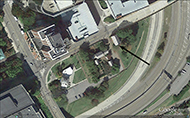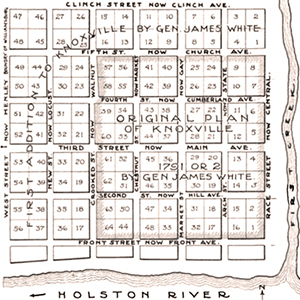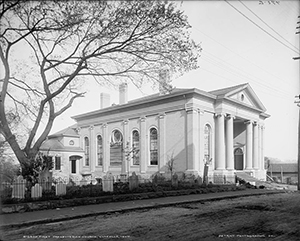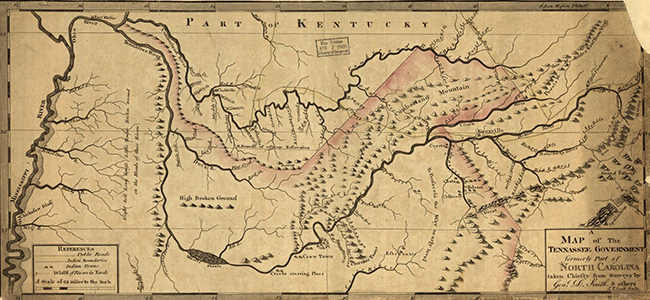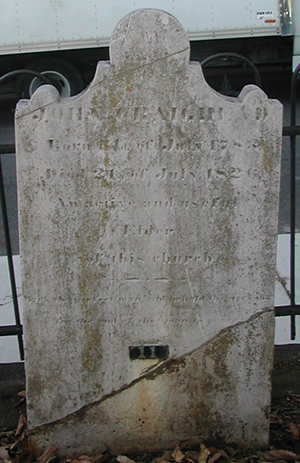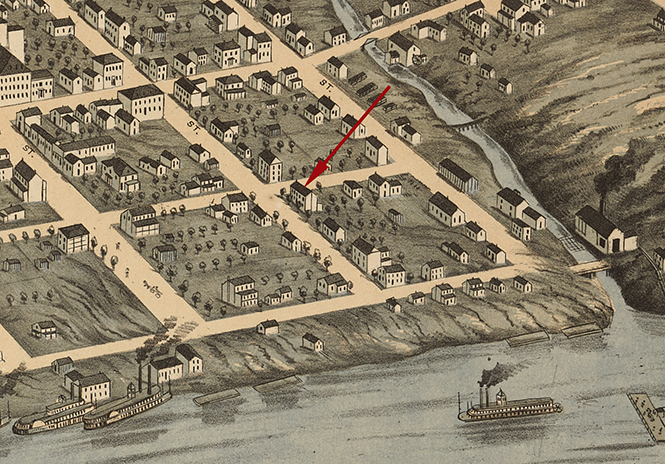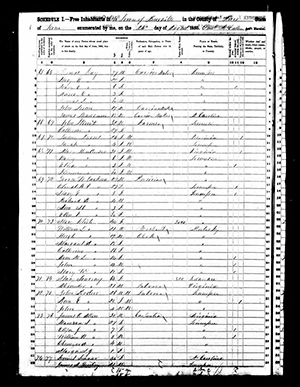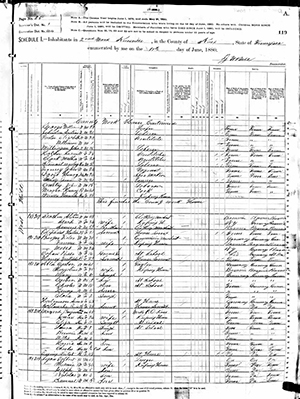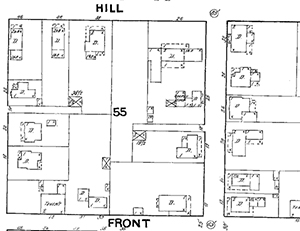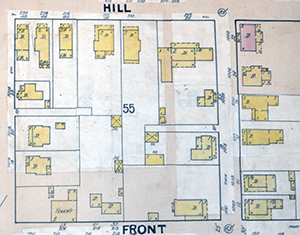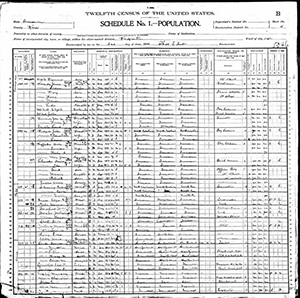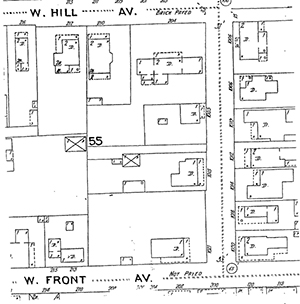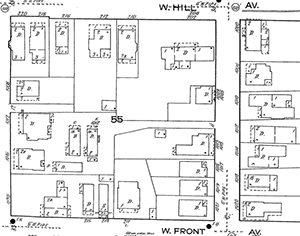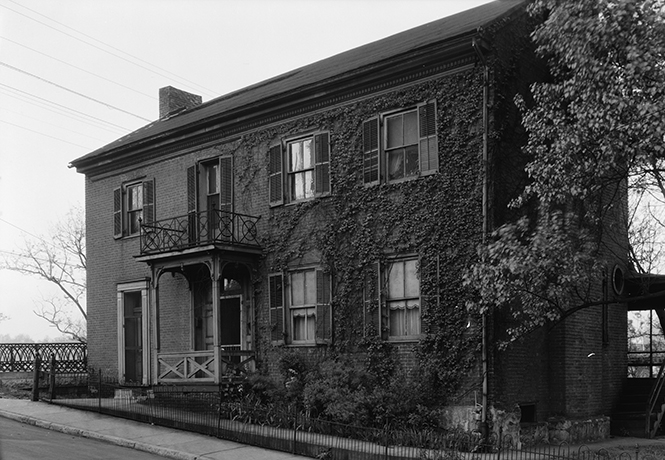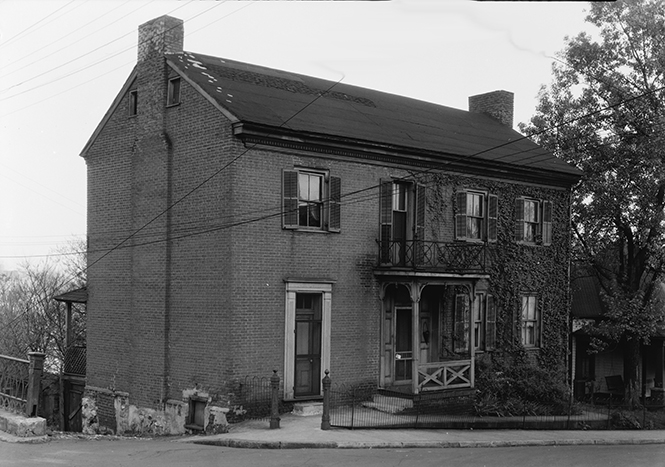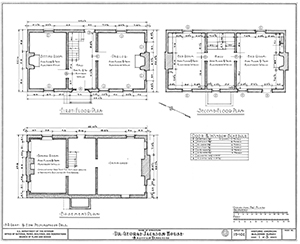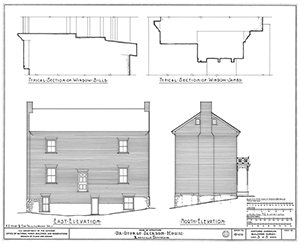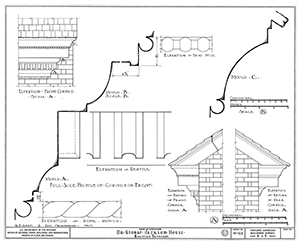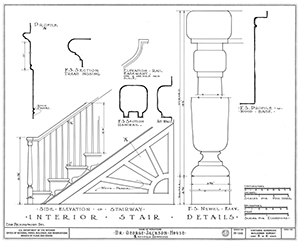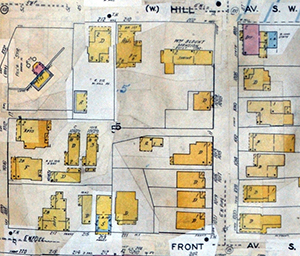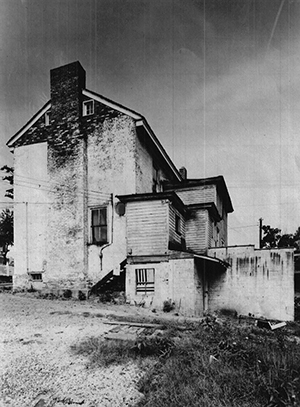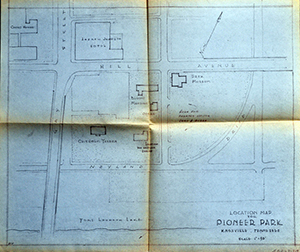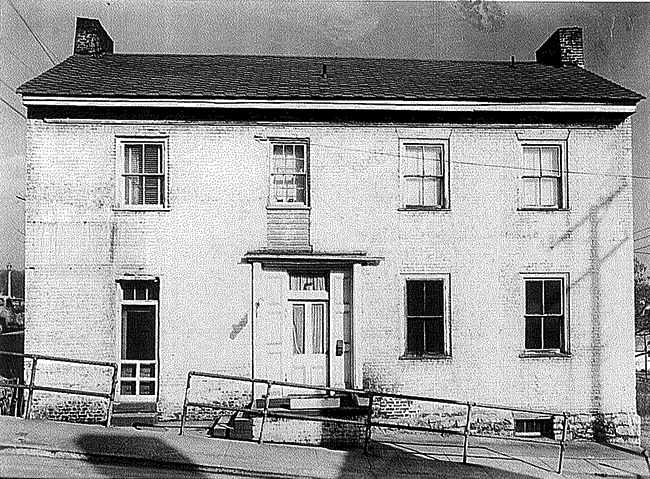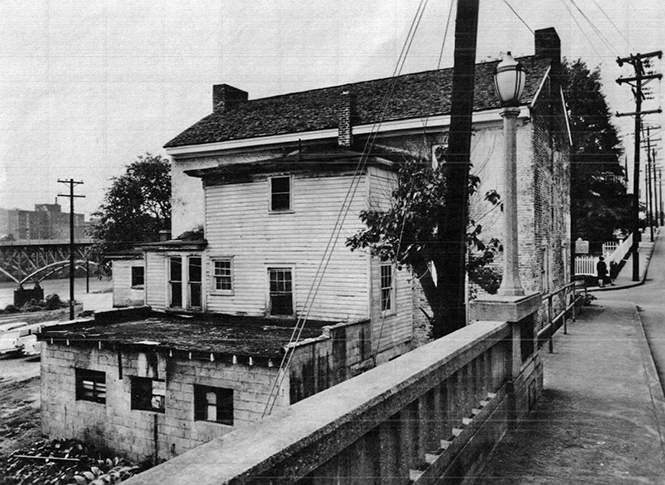Located at the corner of W. Hill Avenue and State Street in downtown Knoxville, Tennessee, the Craighead-Jackson-Aebli House was built in 1818 for John Craighead (1783-1821), scion of one of the city's pioneering families. Documented by the Historic American Buildings Survey in 1934, the house was the residence of Dr. George Jackson (ca. 1821-ca. 1861) and his family from the late 1850s until 1885, when his children sold it to Caspar Aebli (1838-1914). The Aeblis remodeled the house and owned it until World War II. By the end of the war, the house had been remodeled again and divided into apartments.
|
Figure 1. Craighead-Jackson House, March 2014. |
|
Figure 3. Knoxville Presbyterian Church, 1906. |
Efforts to preserve Blount Mansion, which is located across State Street, began in the 1920s; but not until it was too late was there a real effort to thwart the complete destruction of what remained of late eighteenth and early nineteenth century architecture in downtown Knoxville. Proposals for "Pioneer Park" failed after plans for a four-lane, divided highway along the riverfront and up First Creek were made public. In 1957, the City of Knoxville acquired the Craighead-Jackson House and eventually conveyed the house to the non-profit Blount Mansion Association, which restored it in the mid-1960s. It remains a landmark in downtown Knoxville.
Knoxville
Among the early Euro-American settlers in East Tennessee was James White (1747-1821), who moved from North Carolina to a thousand-acre tract around the junction of the French Broad and Holston rivers in 1785. The following year, he built his own "fort" on the banks of the Tennessee River at First Creek and, in 1791, platted sixty-four half-acre town lots, laid out in sixteen blocks. White reserved lots for himself, a church, and a college and set aside the waterfront as a town common. On 3 October, the remaining lots were distributed by lottery, with title requiring only an eight-dollar registration fee. Thus was Knoxville born.
Hugh Dunlap, who came to Knoxville in 1792, recalled during preparations for the fiftieth anniversary of the city’s founding that the "whole town was then in a thicket of brushwood and grape-vines, except a small portion in front of the river, where all the business was done." Two years later, a traveler noted the city's “rapid growth” and that he saw “frame houses and brick chimnies.” In 1795, James White platted additional lots north and west of the original blocks, which doubled the town's size.
In June 1796, Tennessee was admitted to the Union as the sixteenth state, and Knoxville was designated state capital, The town remained the capital for sixteen years; but whatever the rapidity of its early growth, Knoxville stagnated as the state's population expanded westward in the early 1800s. When the state capital was moved to Murfreesboro in 1812, Knoxville's population was still less than 800. The capital returned to Knoxville in 1817-1818; after it was removed again, the city's economy depended mostly on the commercial advantages of the town's location on the Tennessee River. Even then regular steamboat service did not begin until 1835, and the first railroad did not arrive until 1856.
The Craigheads
The house was built by John Craighead (1783-1821) in 1818. His grandparents were part of the great migration of Scots-Irish that settled the colonial backcountry in the decades before the Revolution. A grandson’s obituary noted that his “ancestors were originally from Scotland, but at an early age [late 1650s] they went to North Ireland on account of religious freedom and came to New England about 1715, taking part in the War of Independence.” [1]
John Craighead was born in Mecklenberg County, North Carolina, the fifth child of Rev. Robert Craighead (1751-1821) and his wife Hannah Clark Craighead (1751-1813). They were active Patriots during the Revolution, Robert being badly wounded at the pivotal battle at Guilford Courthouse in March 1781. John Craighead was the grandson of the pioneering Presbyterian minister Rev. Alexander Craighead (1715-1766), who organized the first congregation in the Carolina Waxhaws in the 1750s. John’s uncle Thomas B. Craighead (1750-1825) himself organized the first Presbyterian congregation at Nashville and was a mentor to the young Andrew Jackson, who was also born in the Waxhaws. [2]
By 1790, what had been claimed as western North Carolina was being reorganized as the Territory South of the River Ohio, or Southwest Territory, Robert and Hannah Craighead moved the family, which by then included seven children, to land purchased from Colonel Francis Ramsey (1764-1820) on the Holston River, six miles above the future site of Knoxville. They would have almost certainly been among the large crowds in 1789 and 1790 who heard preaching at the ancient Indian mound at the junction of the Holston and French Broad Rivers and were among those who, in 1791 organized Lebanon-in-the-Forks Presbyterian Church, one of Tennessee’s first Presbyterian churches. The following year, the family moved to the newly laid-out town of Knoxville, where they were among the charter members of the city’s First Presbyterian Church. Although in its third building today, the church remains on its original site on State Street, three blocks north of the Craighead-Jackson House.
|
Figure 4. Reid's "A map of the Tennessee government, formerly part of North Carolina," from Carey's Atlas, 1795. |
Where Robert and Hannah Craighead and their eight children lived in the 1790s has not been documented. The 1795 plat of Knoxville indicates that he owned both the northern half of Lot 15, where his son would later build the Craighead-Jackson House, and all of Lot 16 to the south at the corner of State and Front Streets. Quite possibly the latter was the site of their house, which would have put them in one of the busiest areas in the nascent city, then still very much tied to the river. Robert Craighead was an attorney and justice of the peace for Knox County for many years. Active in civic affairs and in other personal ventures, he is thought to have built the town’s first jail, a palisaded structure at the corner of Gay and Main Streets. [3]
Hannah Craighead died in 1813 and Robert in 1821. His will noted that “my handwriting is so well known it need not be witnessed and expect it need not be acted on in court.” He also instructed that “[w]hatever my children might desire to expend on my funeral or grave, more than a decent burial, let them expend it to some charitable use where a little may produce uncalculable benefit.” [4]
The life of their son John Craighead remains poorly documented. He was, like generations of his Craighead ancestors, beginning in seventeenth-century Scotland, “an active and useful elder in the First Presbyterian Church,” where his wife’s brother Thomas H. Nelson (1776-1838) was pastor from 1812 until 1838. Nothing has been documented of John Craighead’s education and little of his work. He built a grist mill on the east bank of First Creek just south of the Main Street bridge and also inherited his father’s interest in “the saltpeter cave plan.” Whatever the source of his wealth, he was prosperous enough to construct a fine brick house in Knoxville around 1818. [5]
John Craighead married Temperance Nelson (1787-1842) in 1806. She was born in Rockbridge County, near Lexington, Virginia, but came to Knoxville as a child, perhaps with her older brother Thomas, future pastor of Knoxville’s Presbyterian Church. They had at least three children: Eliza in 1809, James in 1812, and Robert in 1814. Where John and Temperance Craighead and their children lived prior to building the house on State Street has not been documented, but it could have been with his parents. [6]
Lot 15
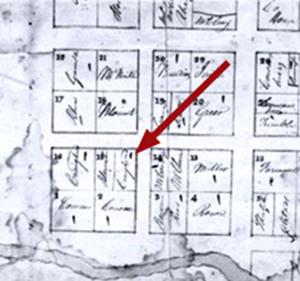
Figure 5. Detail from the 1795 plat of Knoxville, showing the sub-division of Lot 15 and annotated to locate the northern half of the lot, labeled “Craighead.” (North is to the right in this image.) |
The Craighead-Jackson House is located on Lot 15 in the original plan of Knoxville. Joseph Anderson (1757-1837), one of three judges in the Southwest Territory in the 1790s and later U.S. Senator for Tennessee, drew the lot in the lottery held in October 1791. For unknown reasons, James White regained title to the lot and sold the southern portion to William Blount in July 1792. Blount, in turn, sold it to Charles McClung two years later.
The identity of the “Craighead” noted on the original 1795 plan of the city as owning the northern half of Lot 15 and all of Lot 14 has not been definitively documented, but it must not have been nine-year-old John Craighead, as is often reported. Most likely, it was his father, Robert, who acquired the property from James White in 1792. Given the long period of Craighead ownership prior to construction of the present house, there is the possibility of an earlier building on the site. Rule’s Standard History of Knoxville provides some suggestion of that possibility when, in describing the earliest development of the town, he writes that “Col. McClung’s clerk’s office was on the corner afterward known as Craighead’s.” However, it is not certain that the reference is to the same corner on which the house now stands, since McClung also owned the southern half of Lot 15. [7]
Craighead House, 1818-1855
There is no reason to dispute the 1818 construction date for the house; and although supporting historical documentation for the date may be unclear, Fore’s materials analysis in 2014 supports a construction date around that time. The builder of the Craighead-Jackson House has not been identified, but the HABS architect that recorded the house in 1934 thought that its “frame cornice and details show unmistakably the same talent as that employed in the Blount and Chisholm houses.” [8]
At least five carpenters were at work in Knoxville as early as 1806, one of them the noted carpenter/architect Thomas Hope (1757–1820). British-born, Hope was active in East Tennessee beginning in 1796 when he set up his shop on Barbara Hill in Knoxville and advertised as a house carpenter and joiner. Among his earliest work in Tennessee was a house for Francis Alexander Ramsey, which he built near Knoxville in 1797. He built a number of other residences in the early 1800s, including Charles McClung’s State’s View (1805) just west of Knoxville and a house (1814) for Dr. Joseph C. Strong on State Street at Cumberland, one of the few in Tennessee to have a full, Georgian four-room plan. Some historians credit Hope with the James Park House (1812) on Cumberland Avenue as well. Noted architectural historian James Patrick wrote, “Thomas Hope was responsible for some of the best architecture built in the upper counties before 1820.” [9]
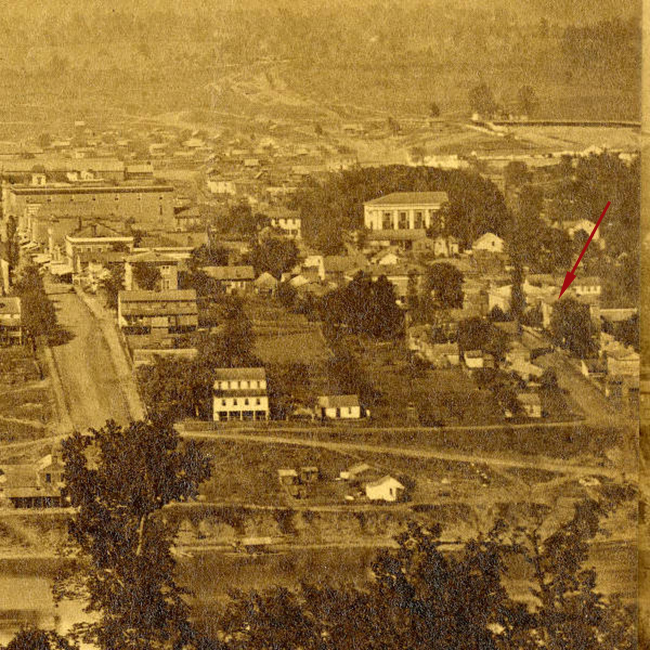
Figure 6. Detail from Theodore M. Schleier, “View of Knoxville, Tennessee, 1865,” part 3 of 4, annotated with an arrow to locate the Craighead-Jackson House. (McClung Historical Collection, Knoxville Public Library) |
No particulars of the actual construction of John Craighead’s house have been documented, but Patrick’s Architecture in Tennessee includes an excellent overview of typical building construction during the period. From that we might assume that Craighead hired one of the local carpenters, perhaps Thomas Hope, and worked with him to plan and build the house. The carpenter then would have engaged masons and other tradesmen as necessary to complete the building. Building materials were readily available as there were several local lumber yards, rock quarries, brickyards, and even a nail factory in and around Knoxville in the early 1800s. Hinges and locks, pigments for paint, and window glass were among the few construction materials that were not produced locally and had to be imported from Philadelphia or elsewhere. [10]
There may have been very little grading of the site beyond excavating for the basement, with the spoil used to create a more or less level yard at the south end and in the rear of the house. The house may have been completed in a year or eighteen months. The house that Craighead built had few stylistic pretensions. A vernacular expression of the late Federal period, it has the center-hall plan and regular fenestration expected from the period but without the typical symmetry. The plainness of the exterior is relieved only by the elaborate cornice on the front façade, notable for its bead and rope moldings and gouged dentils.
Most of the original interior millwork has been lost, but it, too, had a plainness of detail only slightly relieved by the sunburst worked into the paneling of the staircase, which remains in the house. The simply carved panel moldings in the hall and the mantels were salvaged from Chisholm Tavern in 1965 but may be similar to what was in the house originally.
The 1934 HABS documentation states that “indications are that the kitchen was in a separate building at the rear,” but offers no clue as to what those indications might have been. One of the earliest useful images of the house is part of the 1871 bird’s-eye view of the city (Figure 4.5) and depicts a wood-framed, shed-roofed addition off the basement at the rear of the house. Perhaps the HABS documentation is correct and this structure housed the original kitchen, but Room 003 was restored in the 1960s and has been interpreted as a kitchen after discovery of a large fireplace and two pintles for a crane, which seem to indicate the room’s use as a kitchen, although Fore was not certain that is the case. The HABS plans also show interior stairs descending under the main staircase to the basement, which might be expected with a basement kitchen. However, Fore shows that the staircase must have been installed in the twentieth century and, therefore, was not an original feature. Fore also found evidence that the north bay of the basement (Rooms 001A-D) originally had plastered walls and ceiling, windows on the north and east, and suggested that it might have been used as a summer dining room. [11]
|
Figure 7. John Craighead's grave marker at the First Presbyterian Church Cemetery. |
John Craighead died in July 1826 and was buried at the First Presbyterian Church cemetery in downtown Knoxville, leaving his widow and youngest son, Benjamin, as executors for his estate. Matthew McClung was among those who took an inventory of the estate, which included eight African-American slaves, the oldest being 26-year-old Celia and 18-year-old Jac, the youngest an unnamed infant. Familial relationships among those enslaved is not clear. There must have been a house built for them on the property around the same time as construction of the main house. The building depicted just down the hill to the east of the house in the 1871 bird’s-eye map is likely to have been quarters for the Craigheads’ slaves, or "servants" as they were generally called before and after the Civil War.
In addition to household furniture and personal property, the inventory lists ownership of the eight African Americans, valued at $2,050, and personal notes owed to the estate totaling $2,139. The inventory also includes his ownership of $7,700 in real estate: Lots 2 and 29, two-thirds of Lot 15, the saw mill on First Creek, and 25 acres “south of Holston in the first division of Knoxville.” The sawn lumber and “saw logs” on hand at the mill were also inventoried, along with “2 small boat loads of plank sent to Alabama quantity unknown.”
In September 1826, Eliza H. Craighead (1806-1831) married James M. M. White, son of Hugh Lawson White and grandson of Knoxville pioneer Gen. James White. The wedding was probably held at her parents’ house on State Street, with her uncle Rev. Thomas Nelson officiating. They had a son in 1827 but James was soon taken ill, perhaps with tuberculosis, and died in Alabama as they were moving to a warmer climate in November 1828. Eliza returned to Knoxville and in February 1829 gave birth to their second child. Eliza and her two small children most likely continued to live with her mother on State Street until 1834, when she married Col. William B. A. Ramsey (1799-1874). They had two daughters before both of Eliza’s children from her first marriage died within a month of each other during an epidemic in 1838. Eliza herself died in September 1839. [12]
John and Temperance Craighead’s sons James Patterson Nelson Craighead (1812-1854) and Robert Craighead II (1814-1889) were both successful merchants in Knoxville. Robert and his brother-in-law Colonel Ramsey were also publishers of the Knoxville Register in the late 1830s. Robert married Sophia White, daughter of Hugh Lawson White and great-granddaughter of Knoxville’s founder in September 1841. It is not clear where they lived after that.
Temperance Craighead continued to live in the house with her son James Patterson Nelson Craighead until her death in December 1842. James Craighead married Sara Agnes Sutherland (1823-1870) less than three weeks later, but they continued to live in the house on State Street. [13] The 1850 Federal census shows the family with three children — Eliza, John, and Dianna. Also in the household are John and Margaret McMillan, 17 and 18 years old respectively. Whether they were boarders or relatives is not known. Another daughter, Jane, was born in 1851 and a son, James Patterson Nelson Craighead Jr., in 1854.
James Craighead died in September 1854, probably unexpectedly since he was only 42 years old. His widow was forced to sell the house, which her brother-in-law Robert Craighead II did as executor of his brother’s estate. Sarah and her five children along with her father, who was a physician, soon moved to what was then Bexar County, now Wilson County, east of San Antonio, Texas. She died in 1870 and is buried there at Sutherland Springs.
Swan House, 1855-1856
In 1855, Robert Craighead II sold his grandparent’s old house on State Street to William Graham Swan (1821-1869), a prominent Knoxville lawyer and entrepreneur. Swan married Margaret Mabry in 1848 and with her had four children, only one of whom lived to adulthood. In 1853, he and his brother-in-law Joseph Mabry subdivided 142 acres in East Knoxville into residential lots, and that same year Swan donated a lot in downtown Knoxville for development of a farmers market.
William G. Swan began his term as mayor of Knoxville on January 1, 1855, and on January 17 he bought the Craigheads’ old house on State Street. An “extreme man, fond of controversy,” according to Rule, he was a leader of Knoxville’s secessionists in the run-up to the Civil War. No alterations to the old Craighead house can be attributed to Swan, although at a minimum the interior might have been redecorated. He sold the house to Dr. George Jackson in August 1856 and after the war, moved to Memphis, where he died in 1869. [14]
|
Figure 8. Detail from Ruger’s bird’s-eye view of Knoxville, 1871, annotated with an arrow to indicate the Craighead-Jackson House. John Craighead’s saw mill on First Creek is visible at top right. The Craighead-Jackson House is shown with five bays rather than the four it had. Perhaps more reliably, the map also shows a small structure on the back half of the lot that could have been quarters for the Craigheads’ slaves. Ruger’s maps are generally accurate in their depiction of a building’s shape and size, but less so with fenestration. (Library of Congress) |
|---|
Jackson House, 1858-1885
George W. Jackson was born in Tennessee in 1821, but his parents have not been identified. He married Elizabeth V. Truslow in Knoxville in July 1841. Almost no historical documentation has been located for Jackson beyond what is contained in the 1850 Federal census of Knoxville, in which he is listed as a “physician,” age 29, with his 27-year-old wife, Elizabeth, and their four children, Mary, Richard, Ann, and Ellen. After that time, George Jackson is lost from the record, although the 1870 census shows two more daughters, Julia and Fanny, were born in 1851 and 1855 respectively. The family has not been located in the 1860 Federal census, but it is believed that the Jacksons were staunch abolitionists and were part of the Underground Railroad followed by runaway slaves. [15]
|
Figure 9. Schedule for 1850 Federal census, enumerating Dr. Jackson's family. They have not been located in the 1860 census. |
George Jackson is thought to have died in 1861, but his grave has not been located. When the Federal census was taken in 1870, his widow, listed as “E. V.” in the census schedule, is shown living with her five living children. Her son Richard was a merchant, probably supporting the family, although Elizabeth still claimed ownership of $4,000 in real estate, which was probably the value of the house at that time. The family’s position in the census schedule supports the assumption that they were still living at what is now 1000 State Street.
There is no documentation that suggests what, if any, alterations the Jacksons made to the house, but there must have been some. At the very least there would have been the need to replace the original wood-shingled roofing.
Colors and symbols in the 1885 Sanborn Fire Insurance map confirm a two-story brick house with a wood cornice in front, a wood-shingled roof, and a full-width, one-story porch at the rear. The rear porch had a metal roof.
Also of interest in the 1885 map is the small room shown at the southwest corner of the porch. If the scale is correct, it would have been no larger than about 8’ by 10’ and, according to map symbols, it, too, had a metal roof. The Jacksons may have been responsible for its construction if they followed the typical pattern of abandoning an open fireplace for cooking in favor of a cast-iron cook stove. It is possible that they installed the two-over-two sash and the louvered shutters evident in early photographs, both of which could date to the third quarter of the nineteenth century, but were more likely part of a larger remodeling in the late 1880s.
Contrary to the National Register nomination, which states that the Jackson family owned the house until the late 1870s, the Jacksons actually owned the house until November 1885. Elizabeth Jackson may have died by that time, but none of the family has been located in subsequent city directories or Federal census schedules, and it is not certain when or where she died. [16]
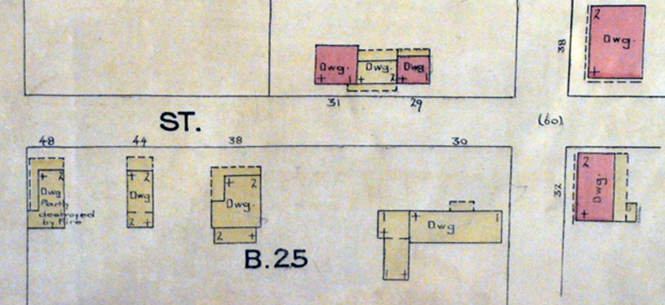
Figure 10. Detail from Sanborn Fire Insurance Company map of Knoxville published in 1885, showing buildings at intersection of Hill Avenue and State Street. Craighead-Jackson House is at center right, 32 State Street, in this image. |
|---|
Atkins House, 1885-1886
On November 23, 1885, the Jacksons sold the house to Samuel Thacker Atkins (1824-1900) and his wife Nancy E. Ault Atkins (1823-1892). They married in 1846 and had at least five children. Atkins owned a sawmill, and in 1876 began operating a furniture manufacturing company that employed as many as 35 workers by the mid-1880s.
Atkins owned the Craighead-Jackson House for only a few months, and he probably never lived in it. He is known to have bought and sold real estate for investment, including other property on Hill Avenue, and it is likely he bought the house for that reason. In 1860, he bought the old Joroulman house on Lot 31 at the corner of W. Hill Avenue and Gay Street.
Aebli House, 1886–1922
On July 15, 1886, Caspar Aebli (1838-1914) took title to the Craighead-Jackson House, which was renumbered 1000 State Street in the 1890s. He was almost certainly responsible for many of the alterations evident in historic photographs and documented by Fore as dating between ca. 1880 and 1920. [17]
Aebli was born at Bilten, Glarus, in the German-speaking northeast of Switzerland, and in 1862 married Magdalena Oswald. They had a daughter Marie (1863-1939) before Magdalena Aebli died in November 1865. Six months later, Caspar married Magdalena Blum (1845-1924), who was also from Bilten. A son Casper Jr. (1867-1890) was born in Switzerland before the family emigrated in January 1869. They set sail from Bremen, Germany, on the Norddeutscher Lloyd Company’s ship Donau and arrived at New York on February 1, 1869. The Donau had only been launched the previous October, and it is likely that Caspar and Magdalena were not traveling in steerage. [18]
Their destination from the beginning was Knox County in East Tennessee where their friends the Staubs were already living, part of the thriving colony of German-speaking Swiss in Knox County since the late 1840s. The Aeblis were probably in Knoxville by the summer of 1869, and in March 1870 their third child, Fritz Charles Aebli, was born. Two more children followed—Henry Harvey in 1874 and Clara Magdalena in 1878—and all would spend their lives in Knoxville. [19]
Casper Aebli Sr. was not a poverty-stricken peasant fleeing oppression but rather an apparently prosperous tailor, able to claim $3,000 in real estate when the Federal census takers came around in June 1870, only a year after his immigration. By then the Aeblis were living in Knoxville’s Third Ward where his immediate neighbors were Swiss tradesmen like himself, among them a carpenter, a hatter, and a shoemaker.
|
Figure 11. Schedule from 1880 Federal Census of Knox County, enumerating "Caspar Abla" and his family. |
|
Figure 13. Detail from 1898 Sanborn Fire Insurance map of Knoxville. |
|
Figure 14. Schedule from 1900 Federal Census of Knox County, enumerating the Aebli family living at 1000 State Street. |
|
Figure 15. Detail from 1903 Sanborn Fire Insurance map of Knoxville. |
In the 1880 census, the family is shown living on West Hill Avenue; by 1884, according to the city directory, they were living at 142 W. Clinch Avenue, just east of State Street and four blocks north of the Craighead-Jackson House. It was around that time that Caspar Aebli began several years of service as treasurer of the Knoxville Building and Loan Association, a company that appears to have failed in the 1890s. He was also a charter member of the Knoxville Chamber of Commerce.
In February 1885, the Aeblis’ daughter Marie married Samuel B. Dow (1839-1928), a wholesale grocer in Knoxville. They would give the Aeblis seven grandchildren. Casper Aebli Jr. and Amelia Augusta Aurin married in October 1889, but he apparently died in November 1890 before any children were born.
The first alteration that can be surely dated occurred between 1885 and 1890 and was probably initiated by the Aeblis shortly after they acquired the house. The Sanborn maps show that during this period the small entrance porch that appears in later photographs was built at the front entrance. The window above the front door was changed into a door from Room 202B and the roof of the porch was surrounded by a wrought-iron balustrade.
Probably at the same time, the original front door opening was widened to accommodate the door and sidelights seen in historic photographs. The noted preservation architect Charles E. Peterson (1906-2004), who investigated the house for the Association in the 1960s, concluded that the window on the second floor over the front door was also lengthened at this time.
The other change evident in comparing the 1885 and 1890 Sanborn maps is that the back porch and the small ancillary room were completely replaced during that period. By 1890, a large, one-story room accessed from the center hall is present. It was almost certainly built as a kitchen. The new kitchen was flanked by one-story, open porches on both the north and the south. The north porch was probably used as a service porch with no connection to the main house, but the south porch likely utilized the door into Room 103. The Sanborn maps show the south porch extending somewhat beyond the end of the house, probably to accommodate a short flight of stairs descending to the west from this extension. It is not clear if these are the same porches glimpsed in the HABS photographs, but quite possibly they are.
In 1892, construction of the first Hill Avenue bridge over First Creek must have been hugely disruptive for the residents at 1000 State Street. Built by King Iron and Bridge Company, the bridge including raising the grade of Hill Avenue, bringing it closer to the first floor of the Craighead-Jackson House. Windows at the north end of the basement must have been eliminated at this time, and it is easy to imagine how increased traffic and noise could have precipitated elimination of any windows that might have existed on the east side of Room 101, which the Aeblis may have used as a formal parlor. [20]
A glimpse of the Aebli family on State Street can be had in the 1900 Federal census of Knoxville. Their house was no longer numbered 32 State, but had been renumbered 1000 State Street. The census schedule enumerates the residents as Casper Aebli, tailor, born June 1838 in Switzerland; his wife Magdalene, born in January 1845 also in Switzerland; son T. Charles born in May 1870 and employed as a “theatrical agent”; son Henry H., born August 1874 and whose employment is shown as “Stock Keep Traction Co.”; and daughter Clara, born June 1879. In June 1900, the Aeblis’ son Henry married Mary Margaret Miller of Attica, Ohio. Before World War I, they moved to a house at 917 E. Hill Avenue. His brother Charles and his sister Clara never married and continued to live at home with their parents on State Street.
By the time the 1903 Sanborn map was published, water and sewer had been run down State Street and Hill Avenue, and both streets were paved with brick. The house almost certainly had running water by then, at least to the kitchen. Sometime between 1898 and 1903, part of the porch on the south side of the kitchen was replaced or enclosed, perhaps for a bathroom. The only other changes that might be noted in the 1903 map is that the north porch remained roofed with wooden shingles, while the roofs of the south porch and the room or rooms between the two porches were all roofed with metal by that time. Close examination of one of the HABS images from 1933 suggests that this metal roofing on the porches was stamped, “tin” shingles.
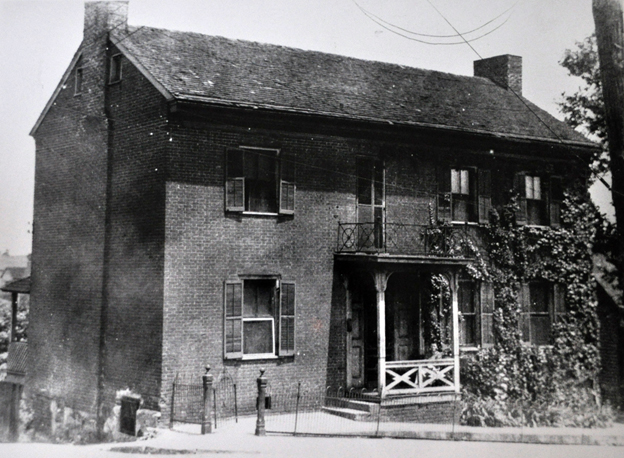
Figure 16. View of the Craighead-Jackson House in the early twentieth century. The seated figure on the front porch may be Mrs. Aebli. (Blount Mansion Association Collection) |
|---|
|
Figure 17. View of Craighead-Jackson House, ca. 1930, showing new entrance on west side of Room 101. A similar photograph is part of the HABS documentation. (Blount Mansion Collection) |
The 1910 Federal census schedule enumerates Caspar and Magdalena Aebli living alone with a boarder, who also was a tailor, but their unmarried children, Charles and Clara, were probably still living at home. Seventy-tw0-year-old Casper himself had retired from his tailor shop and was employed as property manager for Knoxville Office Company, but he soon retired.
On July 6, 1914, Caspar Aebli got up from breakfast, spoke to his wife, and dropped dead. The obituaries following his “sudden summons” were extensive, he was lauded as “an exemplary citizen, a loyal friend, a devoted patriot.” The funeral was held at his home the next day and he was buried in Old Gray Cemetery. [21]
His widow and two unmarried children continued to live at 1000 State Street during World War I. In November 1919, the two youngest of the Aeblis’ sons, Charles and Henry, died within a week of each other, two of the millions swept away in the great Spanish influenza pandemic after World War I.
In 1919 or 1920, Magdalena Aebli and her daughter Clara moved in with the Dows on Second Street and it was apparently there where Mrs. Aebli died in 1924. She, her husband, three of their five children, and two or three grandchildren are buried at Knoxville’s Old Gray Cemetery, where Robert Craighead and others of his family are also buried.
Rental Property and Decline, 1922-1957
Clara Craighead died in 1931, holding title to the family home on State Street, and her nieces and nephew inherited the property. They still owned the house at the outbreak of World War II, and continued to maintain it as rental property.
The city directories make it clear that the house was used as rental property until it was acquired by the city in 1957. When the Federal census was taken in January 1920, the house was being rented by a 38-year-old widow Callie E. Lane and her four sons. They moved away in 1922 and a mason and contractor named Russell W. Hoss lived there for a year.
|
Figure 18. Detail from 1917-24 Sanborn Fire Insurance map of Knoxville. |
A Sanborn map was published for Knoxville in 1917 and updated in 1924, with no apparent changes evident at 1000 State Street between those dates, but several evident since the 1903 map. The map shows a second story had been added over or in place of the earlier, one-story addition at the center of the rear of the house, perhaps to house an additional bathroom and/or kitchen. But the 1925 city directory only shows a two residents in the house, Rudolph W. Kersenski and his wife, who must have lived there barely a year. His occupation is shown as timekeeper for the L&N Railroad.
Perhaps as early as the summer of 1923, Gains Cora Emmett and Robert G. Emmett rented the house and began operating their business out of the first floor. They could have been responsible for creating a separate exterior entrance for Room 101, perhaps to facilitate its use as a showroom. If Room 103 was being used for furniture repairs, it would have needed extra ventilation to deal with the off-gassing from glues, shellac, lacquers, and other finishes. For that reason the Emmetts might have been responsible for installation of a large exhaust fan high on the southwest wall of Room 103. The opening is evident in one of the HABS images and in one of the images from 1963. It appears to have been around 24” to 28” in diameter, with its top more or less aligning with the top of the window. The antique shop appears sporadically in the city directories, and may have continued to operate throughout the 1920s, although the 1925, 1927, and 1929 directories show the address “vacant.”
The directories from 1930 and 1931 show Humes Tea Room at 1000 State Street, and if the antique dealer had not already installed the second front door in Room 101 and the exhaust fan in Room 103, the operators of the tea room certainly did, since both features were present when the HABS photographs were made in 1934. A sign advertising the tea room is visible in one of the photographs taken before 1933. From 1932 through 1937, May Leland and E. E. Marshall appear in the Knoxville city directory at 1000 State Street in alternate years, except in 1936 when they are both shown living there.
|
Figure 19. Craighead-Jackson House as photographed by the Historic American Buildings survey in 1934. |
|---|
|
Figure 20. Another image from the Historic American Buildings survey in 1934. |
In 1934, Memphis architect James J. Broadwell was hired by the Historic American Buildings Survey to record “The Jackson House” on State Street in Knoxville. On April 28, 1934, he produced five sheets of drawings, including plans of all three floors, elevations of all four sides of the house, and detailed drawings showing door, window, and trim profiles. There are also two large-format black-and-white photographs of the exterior.
It is not always clear how much Broadwell’s drawings were intended to be record drawings and which features were restoration drawings, showing the house as he thought it existed originally. In his drawings, he omitted the exterior door on the west side of Room 101 and the one on the second floor at the west side of Room 202B, but included the 1880s front porch. In his plans and elevations, he omitted any back porch at all, and on his elevation of the south end of the house he showed steps descending to the back yard from the street level, rather than ascending to the back porch from street level, as photographs show that they did during this period.
It is not clear if his rendering of basement fenestration represents 1934 conditions or his supposition of conditions in 1818. He shows what are apparently small barred windows at the south end of the basement, two windows at the north end, and two windows and a door on the rear.
Broadwell’s plans show the south room in the basement (Room 103) as unfinished. Fore has found evidence that both that room and the basement hall (Rooms 002 A-B) once featured exposed first-floor joists that had been whitewashed. Broadwell shows a room at the northern end of the basement (Rooms 001 A-D), with plaster walls and pine flooring. Fore has found physical evidence of plaster, but not of pine flooring, although a wood floor would not at all be unexpected.
On his plan of the basement, Broadwell shows stairs rising on the north wall beneath the main staircase, but Fore found no evidence for basement stairs. His analysis concludes that there was insufficient headroom for basement stairs as Broadwell drew them. He notes that basement stairs would have been possible in the location shown on Broadwell’s plan if the staircase were moved from the original position. Because of the extent of later alterations, the original condition may never be known.
On the interior, Broadwell shows a second-floor stair hall, without its present north-south partition wall. This might have been typical of the early nineteenth century, but the wall appears to be a structural necessity in the present house and he may have been incorrect in assuming that the Craighead-Jackson House followed that pattern.
He also shows a small stair, apparently ascending to the attic, in a closet at the south end of the south bedroom (Room 203) on the second floor. Most likely this is the same closet mentioned in the final report on the building’s restoration in the 1960s, during which some of the original baseboard was discovered.
In August 1937, the Knoxville Journal ran a short article about the Craighead-Jackson House. It noted that the brick
rival in freshness of appearance the bricks in the nearby Andrew Johnson, Knoxville’s newest hotel . . . . The floors have not sunk. The old sand, lime and hair plastering is still on the walls. The gingerbread work on the outside has not fallen prey to termites, woodpeckers, or decay. Down in the cool brick floored basement, an ancient copper press still stands, bearing mute evidence to the fact that the kitchen and dining room were once located there.
Construction of the present Hill Avenue bridge in 1936 no doubt repeated the disruptions experienced with construction of the 1892 bridge; when completed, the grade of the intersection of Hill Avenue and State Street was as much as two feet higher than the first-floor level at the north end of the house. By the time information for the 1938 directory was collected late in 1937, no one was living in the house. Instead, Ca. L. Peckinpaugh & Sons, building contractors, and W. F. Cale Electric Co. are shown at that address and continue through the 1942 directory. One year, 1939, Rudy Heating Co. was also shown at 1000 State Street. One of these companies may have been responsible for construction of the one-story concrete-block structure that first appears in the 1948 Sanborn map. It is later reported to have been used as a welding shop.
It is not clear when the Aebli heirs no longer owned the Craighead-Jackson House, but in 1943 the Home Owners Loan Corporation (HOLC) appears to have funded a major remodeling of the house. The work has also been attributed to the Federal Works Projects Administration (WPA), but it is not clear how the WPA would have used HOLC funding. Whatever the source of funding or project management, the remodeling created three apartments that were meant to provide affordable housing at a time when there were severe housing shortages in Knoxville and all across the country. The city directories also indicate that the house was vacant from the fall of 1942, and the 1944 directory is the first to show apartments in the house.
|
Figure 26. Detail from 1948 Sanborn Fire Insurance map of Knoxville. Yellow represents wood-framed structures, red represents brick structures, and blue represents concrete block. |
|---|

Figure 27. The Craighead-Jackson House, ca. 1960. |
|
Figure 28. South side of Craighead-Jackson House, 1963. |
According to Eleanor Keener’s report on the BMA’s restoration of the house in the mid-1960s (see Appendix G), the work included moving the main staircase three feet to the west, “narrowing the upstairs hall.” It is not clear why this was done but it may have been to provide a new entrance from the second-floor apartments into the two-story rear addition, where the bathrooms were probably located. Whatever its purpose, Keener wrote that all of the door openings on both floors were “closed off” and relocated. This may have been when the closets that Keener reported were built in some of the rooms, and plumbing vent stacks visible in photographs from the 1950s and later photographs document that kitchens were installed for each apartment at the same time.
This may also have been when two windows were opened on the north side of Room 101. With its front entrance intact and its connection to the first floor eliminated, that room continued to function as a commercial space. Most likely it was at this time, too, that the fireplaces were closed and mantels removed. All of the interior changes resulted in disappearance of all but one of the original doors and most of the interior woodwork.
It is not clear when several other major alterations were made to the house, but it is likely that most if not all of those changes that the BMA faced in the 1960s were associated with the work in 1943. Hexagonal asphalt shingles visible in later photographs were likely part of this work, replacing the asphalt roll roofing visible in the HABS photographs of 1934. There were later complaints about the huge mess that was left in the attic from the work.
By the fall of 1943 when information was collected for the next year’s city directory, there were three apartments in the house, most likely one on the south side of the first floor and two on the second floor. In 1947, W. G. Smith moved his orthopedic “appliance” company into Apartment 1 with its separate exterior entrance, and it would remain there until 1957. He may even have lived in the house for part of that period. The other two apartments were rented throughout that period. J. E. Monroe lived in Apartment 2 from 1945 until 1952, and E. W. Jordan lived in Apartment 3 from 1947 until 1954. Other tenants were in residence for only a year or so, except for Mrs. L. P. Parker who lived there in 1956 and 1957. Their lives remain undocumented.
By the early 1950s, Holland N. McTyeire, a Tennessee-born attorney, may have already acquired the property and could have been responsible for removing the front porch, which is still present in the 1948 Sanborn map (Figure 4.20), and it seems likely that the shutters were removed at the same time. The removal of these features would almost certainly have left its mark on the masonry, and simply painting the masonry along with what remained of the wood trim would have been expedient. Exactly when all of this occurred has not been determined, but it must have been around 1950, given the poor condition of the white paint by 1957 (Figure 4.19). In the mid-1950s, when the Association still knew little of the house’s history, the BMA board minutes refer to the Craighead-Jackson House simply as “the white house.”
There had been a proposal to demolish the William Blount Mansion in 1925, prompting formation of the Blount Mansion Association and their subsequent preservation of that house (see Chapter 3). The neighborhood continued to decline, and after World War II, most people saw little value at all in the 150+ year-old buildings along Front Street and elsewhere around Blount Mansion.
As seen in Chapter 3, to combat that trend in Knoxville, local history buffs conceived the idea of a “historical park” centered on Blount Mansion as early as the 1940s. By 1957, these plans had gelled in the form of the Blount Park Association, which had begun fundraising for “Pioneer Park,” an ambitious effort to preserve and interpret something of the very oldest part of the city that was then being lost to urban renewal and transportation improvements.
Influenced by the success of Colonial Williamsburg, the plan included the Blount Mansion, of course, but also the Craighead-Jackson House and the legendary Chisholm Tavern. They would sit in a large park-like setting at a bend in the new “redevelopment highway” that would soon replace Front Street. The BMA was especially excited about the building thought to have been the Tavern because of its traditional associations with Thomas Hope, the early carpenter and builder who was renowned for his work in East Tennessee and who may have contributed to the construction of Blount Mansion and even the Craighead-Jackson House.
|
Figure 29. The conceptual plan for Pioneer Park. |
|---|
Although fundraising met with some success, the Blount Park Association was dealt a setback when the new highway, christened Neyland Drive, necessitated moving what was still thought to be Chisholm Tavern a few dozen yards north of its original site. Only the main block of the building was moved, and local historic preservationists lamented the use of modern brick to rebuild its chimneys. Mantels, doors, and apparently some of the paneling as well were removed and put into temporary storage.
Fundraising for the park was slow, and by 1959, plans for expansion of Neyland Drive into a limited-access freeway no longer included preservation of so-called Chisholm Tavern. Interest lagged after that, and the Tavern was left to deteriorate until it was finally demolished in 1965. In March of that year, the Blount Park Association turned over the last of its assets to the Blount Mansion Association.
|
Figure 30. Craighead-Jackson House after restoration, 1970. |
|
Figure 31. Craighead-Jackson House after restoration, 1970. |
Preservation and Restoration, 1957-1966
Amid the to create Pioneer Park, in April 1957, Holland McTyeire offered the old Craighead-Jackson House for sale for $15,000. There had already been discussion of possible acquisition of another property, and now the Association saw possibilities in “the old white brick building across the street.” Mr. Beverly Burbage and others were influential in getting a $5,000 appropriation from the state legislature, if it could be matched by Blount Mansion. By June, Burbage was able to report that the state appropriation was raised to $7,500 and was matched by the City of Knoxville.
The city took title to the Craighead-Jackson House in August 1957 and agreed to bear the cost of rehabilitating and maintaining the exterior of the house. For its part, the BMA would raise money “to put the interior in condition suitable for museum purposes,” with operating costs borne by the City Recreation Bureau. By January 1958, Burbage was reporting on research on the property and presented renderings of how the exterior of the house would look if restored. He also suggested calling it the “Craighead-Jackson House.”
The house was in poor shape after little or no maintenance since World War II, but the City and the BMA had what turned out to be an “informal agreement” that the City would maintain the exterior and the BMA the interior. Probably by 1960, the end-gable walls and the upper portion of both chimneys were rebuilt, rather “clumsily” as one observor noted a few years later.
The State of Tennessee offered a second matching grant to help the BMA acquire the Craighead-Jackson House, if the matching funds could be raised locally. The match came from the city when, on August 28, 1962, the Knoxville Housing Authority conveyed the Craighead-Jackson House to the BMA, with the stipulation that restoration begin within six months. The next day, work began.
The BMA’s restoration committee for the work was headed by Eleanor Lloyd Keener, born about 1904 in Massachusetts and married to Bruce Keener Jr., owner of a wholesale hardware house in Knoxville. She worked indefatigably for several years overseeing the restoration of the Craighead-Jackson House. Her untitled and undated report on the BMA’s restoration of the house (see Appendix G)—”written by an amateur for an amateur”—runs to forty-eight pages and documents not only the Association’s restoration of the Craighead-Jackson House but her own learning curve in the process as she offers advice to other would-be restoration managers.
At an early date, the BMA had a caretaker living in the Craighead-Jackson House, perhaps the housekeeper who had been living in Governor Blount’s old office. BMA Board minutes include discussion of new quarters for the housekeeper as planning for restoration of the Office got underway late in 1954, and in June 1955, the minutes reported that an apartment was available at “the white house across the street” (the Craighead-Jackson House) at $37.50 month. By September 1955, the housekeeper was settled into a new apartment and was “quite pleased,” but it is not clear if that apartment was in the Craighead-Jackson House. There are undated plans in the BMA files that appear to show alterations that may have been made for a new apartment in the basement. Whether or not a new apartment was actuallly created in the basement, there was certainly a caretaker living on site for several years prior to 1962, protecting it from the vandalism that was slowly destroying the Chisholm Tavern.
To Keener’s credit and that of the Association, almost as soon as the work commenced, they realized how much they did not know. In spite of the fact that she was a self-professed amateur, Keener and the Association managed to get guidance from some of the best architects and historians in the National Park Service and elsewhere. In the end, money was her most persistent problem: " Money seems to flow away! The only consolation you have is that, when you are through, you have a building that is satisfyingly right--instead of a reproduction of Ye Olde Colonial House or Shoppe."
The committee engaged the services of contractors Johnson and Galyon to help plan and estimate the work. They were a local firm founded in 1914 and remain in business a hundred years later. Keener later wrote that Jim Johnson “should have a special crown in heaven for his patience with a group of women who were demanding perfection—and not paying him any profit for producing it.” He produced a restoration estimate of $23,000, the equivalent of perhaps ten times that much in 2014.
Beginning with $1,000 in seed money from the BMA, the restoration account grew as the committee raised $6,300, which was matched by the Tennessee Historical Commission, for a total of $13,000 early in 1963. The caretaker and his family vacated the house, and by summer work had begun on a “permanent roof.” The committee had some difficulty in finding “authentic wooden shakes,” but by fall the new roof was in place and treated with “a fireproof formula.” Mrs. Keener summarized the other work completed in 1963:
During the summer the roof had been strengthened by new rafters that were put up next to the old ones. All the debris that had been dumped in the attic during repair of the chimneys in W.P.A. days was removed, and the house was cleaned completely. All electrical wiring was pulled out so that there would be no danger of fire, and some temporary wiring was strung up for the use of the workmen. Concrete was poured under the foundation at the corner where the house was settling. The rickety wooden additions at the back of the house were torn away, but the concrete block addition that had housed the welding shop stayed. It was needed to give strength to the rear wall until the brick work was completed.
In the fall of 1963, the BMA consulted with the noted National Park Service architect Charles E. Peterson (1906–2004), one of the great leaders in the country’s twentieth-century movement for historic preservation and a leading authority on early American building practices. He arrived in Knoxville on 30 September 1963 and, as he later reported, spent “three and a half days working on the problems of the Craighead House and the Blount Mansion.” He would return at least three more times, and his recommendations were generally followed, except for his admonition on one visit to “under no circumstances” let the Chisholm Tavern be demolished.
Peterson began his work directing photographer Harley D. Ferguson in making “before” photographs, mostly of the interior. Although Keener considered Ferguson the best photographer in the city, his camera malfunctioned and no photographs were made of the interior before work began. Peterson also consulted with the noted archivist Pollyanna Creekmore at the Lawson-McGhee Library, but it is not clear what if any new information was gleaned from that visit.
Peterson engaged a local carpenter, Ray Webster, to remove “modern parts of the building. The search was very rewarding,” according to his report. “Especially notable” was finding “the big cellar fireplace” in Room 003, which the BMA later restored. He also found that the “main gable and the top of the chimney stack at both ends of the house were taken down a few years ago and clumsily rebuilt,” a condition clearly evident in photographs from the period but not so apparent today except from inside the attic.
Peterson spent considerable effort investigating the building’s fenestration and believed that the second-floor door above the front entrance and the door on the west side of Room 101 were originally window openings. He thought that the windows that then existed on the east side of Room 101 had been created since the HABS documentation of the 1930s, but it is not clear whether he found conclusive physical evidence to support that date. It is possible the openings were original and had been closed in the nineteenth century and reopened after 1934.
Peterson found evidence that the window to the east of the fireplace in Room 103 was once a door, although he did not note whether it was part of the house’s original construction. He also found evidence for a window opening on the west side of the chimney in Room 103 and included the observation that the wall in that location “seems to have been thickened by adding a four-inch layer of brickwork on the inner face of the wall.”
On the second floor, Peterson’s investigation found, “unexpectedly,” a bricked-up window opening at the south end of Room 103. Finally, Peterson reported that a “derelict window sash three lights by four . . . found in the building . . . appears to be original” and that one of the original four-light sash for one of the attic windows had been found in the attica.
Peterson’s report notes that “the upper part of the main cornice has disappeared” and that the small chimney for the late-nineteenth-century kitchen added at the rear of the house had been cut through the rear cornice. Peterson also found what he thought was evidence for the then-existing, wide, masonry opening for the front door being an original feature, although the door, sidelights, and paneling were contemporaneous with the “mid-Victorian porch.” He would later change his mind on that.
Before leaving Knoxville at the end of the week, Peterson was interviewed by a reporter for the local paper. The newspaper report that followed quoted his saying, “The original walls are good but there is much later construction of very poor quality that will have to be removed. A few thousand handmade brick will be necessary to restore parts of walls cut away by contemporary owners or occupants. The interior will have to be redone.”
In January 1964, Tennessee Gov. Frank G. Clement vetoed an appropriation for the Craighead-Jackson House, but the BMA forged ahead anyway. As the weather allowed, they began trying to strip the paint from the exterior, but it proved resistant to methods suggested by the paint companies. Eventually, their contractor settled on muriatic acid and, as Keener put it in her report, the “beautiful old brick so soft in color it looked like velvet laid in Flemish bond” began to emerge.
By the time Peterson returned in April 1964, the work had proceeded to the point that, as Keener put it,
even an amateur could see where windows had been removed or filled in and places gouged out to change doors. After all, the house is nearly 150 years old, and each generation had changed it—even as you and I change the house we live in.
Keener’s report is not explicit, but Peterson must have found the evidence he needed to determine that, contrary to his initial assessment, there was originally a single front door and transom with no sidelights. Most likely, after his initial visit, removal of the architrave at the front door opening allowed examination of the rough opening in the brick. A photograph made at that time seems to show the left (north) side of the opening in an even, as-built condition, while the right side shows broken brick and patched areas. The somewhat awkward placement of the front door to one side of the main hall must have been an original feature. During that same visit, Peterson also “determined the type of door to be installed, worked on the fireplace in the old kitchen, and studied the location for the porch at the rear of the house.”
That summer, the BMA committee searched for brick that would be needed for restoration. Eventually, the Locher Brick Company of Glasgow, Virginia, provided a “Kenmore” brick that the BMA thought was an “almost perfect match” of the original. The Lochers, who were Swiss, had operated a cement factory in Glasgow since the 1840s and, in 1915, established a brick plant. After World War I, Charles Hunter Locher Jr. took over operation of the plant and, inspired by the pug mill and brickyard at Colonial Williamsburg, developed his own “hand-made” brick that he thought would be popular for the Colonial and Tudor revival style buildings popular in the 1920s. He was wildly successful with his marketing and sold brick all over the east. In 1957, Locher Brick was used for construction of the Abby Aldrich Rockefeller Folk Art Museum at Williamsburg. The Craighead-Jackson House would have only the best.
A local mason, Jim Henry, was hired to do the masonry repairs and to repoint the entire house. He matched the mortar and “painstakingly did the work, brick by brick, in exactly the same fashion as it was laid in 1818.” When he was finished, the house was “painted with a thin coat of liquid cow manure . . . [and] all at once the old brick and the new blended so well it was hard to tell which was which.” The odd brick lintels were also covered with stucco, which Peterson thought was appropriate. When repairs were complete, the walls were coated with silicone.
As the work was underway, the small bricked-up opening that is located to the right of the front door came to everyone’s attention. The mason had found that it “backed against a [joist] in the basement” and even had a little lintel. The feature was much discussed and, along the way, Keener mentioned the find to one of the “hostesses” at the Blount Mansion, who immediately identified it as a sort of cornerstone similar to one they had in their old “home place” five blocks away. When that house was torn down, they found a similar feature full of old letters and newspapers. Apparently the one at the Craighead-Jackson House had already been plundered, but the BMA had “a cornerstone laying and all the pictures and articles about the house that had appeared in the newspapers were sealed in the brick.”
While the masonry repairs were underway, the foundation was waterproofed, which necessitated digging down nine feet in front of the house to apply an unspecified coating. Four steel rods were also “bolted into the house, two lengthwise, two crosswise, to strengthen it.” It is not clear how these rods were installed or where they were located since their ends were apparently covered by brick and mortar.
On the interior, the entire electrical system had been removed in 1963 out of fear of fire, and temporary lighting installed. In the summer of 1964, work proceeded to completely rewire the house, putting all of the new wiring in conduit. By then the BMA was “frightfully poor,” but managed to raise another $9,300 that year and received another $2,000 from the Tennessee Historical Commission. That put them a little over their original goal, but already the BMA realized their original estimates were far too low.
In November, Peterson was back, pointing out the mistakes made in the new door frames. Like all modern doors, the frames included stops for screen doors, something the original frames would not have had. The stops were removed and the frames patched up with wood and putty. A similar mistake was made with the few new window frames that were required. The new frames had mitered corners rather than the butt and pegged corners of the original frames. Once again, patching and plastic wood made the best of a bad situation. Peterson also found the transom at the front door was not correct, but the BMA found one from “an old tavern, built in 1807, that was falling down.”
The original window architraves showed that the house had originally had shutters, and louvered shutters are clearly evident in the HABS photographs. Yet the BMA was advised that either louvered or solid paneled shutters would be appropriate. According to Keener, solid shutters were cheaper, and some liked the contrast with the Blount Mansion’s louvered shutters, so solid shutters were installed. Keener continued to question that decision, shading and ventilation being the primary reason for shutters in the south.
The cornices at the front and the rear of the house were damaged, but all of the crown and bead moldings were missing and had to be reproduced. According to Keener:
Some of the board itself was replaced as was practically all of the soffit, several dentils, and some of the heavy rope molding. A decorative small molding was put under the dentils. This is practically a duplicate of the original, so close that it is hard to tell the difference. All of this decorative molding had disappeared. The rafter header had to be replaced both front and rear.
Around this time, National Park Service architect Orville Carroll, who was then working on restoration of Appomattox Courthouse, was persuaded to visit for “a long weekend.” He was able to locate openings in the brick that identified the width of the original porch framing and spent a good deal of time looking at comparable houses in the area. He also reviewed the Knoxville Library’s photographic collection and, a few days after he left, sent plans for recreating the back porch.
As noted above, the Blount Park Association was dissolved in March 1965 and its assets turned over to the Blount Mansion Association. Realizing Pioneer Park was not to be, the BMA appropriated the money for restoration of the Craighead-Jackson House, provided that some of the interior woodwork from “Chisholm Tavern” be used in the restoration and that a marker commemorating the Tavern be put in the yard of the Craighhead-Jackson House. Both conditions would be fulfilled.
With the new money, the BMA was able to reconstruct the back porch according to Carroll’s plans and to construct the retaining wall that Peterson had recommended for the south end of the house. The limestone from the foundation of the “Chisholm Tavern” was salvaged in 1957 and since it matched the house’s foundation, it was used to build the wall.
In January 1965, William P. Toms, a locally renowned collector of late-eighteenth and early-nineteenth-century furniture and silver, died and left his two collections to a foundation managed by five trustees. It was not long before they had reached an agreement with the BMA to display parts of the collections at the Craighead-Jackson House.
News of the Toms collections energized the project, and later that year, the legislature appropriated $10,000, which was followed by $8,750 from the Tennessee Historical Commission “to complete the house.” There were other smaller donations as well, with the total enough for the work on the interior to move forward by the fall of 1965.
What remained of the original plaster was removed, although it apparently survived on the north walls of Rooms 101 and 102, under the stairs, and at isolated locations elsewhere. The brick walls were channeled for conduit for the new wiring system. In order to avoid unnecessary damage to the walls and to preserve authenticity, all of the lighting was operated from a central control panel located under the stairs on the first floor. Switches were installed in Room 202B and in the basement rooms. Security and fire-detection systems were also installed. It was all state-of-the-art for the period.
A new heating and air-conditioning system replaced the coal fires and gas stoves that had been heating the house. The furnace for the forced-air system was located in part of the old basement coal bin, now Room 001A, the compressor for air-conditioning outside under the Hill Avenue bridge that is immediately adjacent to the house. Conventional, galvanized metal ductwork was installed and distributed through new chases and into the attica. Chases were boxed on both sides of the north chimney stack, which visitors generally did not notice, with the ducting crossing the attic floor to service the rooms on the second floor. A chase was also added across the west side of the basement ceiling to service that part of the house. The cold-air return was placed under the stairs on the first floor, with the duct run in a chase on the north side of Room 002A.
New bathrooms were installed in the old coal bin, which was partitioned into separate restrooms for the sexes, Rooms 001B and Ca. The plumbing vent stack ran through the north chimney with the intent of fire logs disguising the pipe as it ran through the fireboxes in Rooms 101 and 201. Visitors noticed, and another wythe of brick was installed at the back of the fireboxes to conceal the vent pipe.
Orville Carroll recommended that the BMA contact Penelope Hartshorne in Philadelphia for assistance in determining the color of the exterior woodwork. A well-known historical architect with the National Park Service from 1955 to 1992, Hartshorne analyzed one of the original dentils that the BMA sent to her and returned a Munsell number for “an exquisite color . . . coffee with lots of cream in it.” That was to be used on all the exterior trim, but Carroll had already recommended an off-white for the porch posts and balustrades and brown paint for the floor and stairs. Carroll also recommended that the brick under the porch be whitewashed, because he saw it as a service area off the original kitchen.
The masons were brought back and the door openings on the north and south walls of the halls were returned to their original locations. The staircase was also returned to its original location “without even disturbing the railing.” That work was probably done by Loyd Houston Boling Jr. (1943-2013), an apprentice carpenter, who became the “main strength in finishing the house” in 1965, according to Keener. “Nothing was too much trouble for Houston. He was . . . as steady and quiet and competent a workman as one could ever hope to have.” He apparently did most of the finish carpentry.
Two pieces of chairrail and a run of baseboard found behind added closets were the basis for reproducing that woodwork. The basis for recreating the door frames and casings is not clear, but some of the original window casing at least may have survived. No crown molding was found in the house, so the BMA decided to reproduce crown molding from “Chisholm Tavern” and install it in every room.
Much of the antique locks, strap hinges, shutter hinges and pintles were acquired from Sydney Strange, a New York dealer in antique hardware, which was in plentiful supply as so much of old New York was being demolished. This included strap hinges and pintles for the shutters at the front windows, strap hinges for the doors in Room 003, the door closer for the Dutch door in that room, and “two wooden box locks in good working condition” for the Dutch door and the exterior door in Room 002A. Some of the other reproduction hardware, including handmade nails, were acquired from Donald Streeter, Iona, New Jersey, “who specializes in hand forged iron.” Streeter was highly regarded for his work and after his death his papers were acquired by the Colonial Williamsburg Foundation.
The BMA decided to complete all, or at least most, of the work before making a decision on reuse of the “Chishom Tavern” woodwork, which remained in storage. Understanding the issues of authenticity, they were conflicted and even consulted the National Trust for Historic Preservation—”their advice is invaluable, their knowledge encyclopedic”— and asked them “if it would be permissible” to restore the house as a showcase of their collections, architectural and otherwise, and not as a house museum. The Trust responded that “using the woodwork was splendid as we were making no attempt to fool the public by claiming that the house was restored as the Craigheads had lived in it, and to decorate the house to enhance the collection.”
And so the paneling and mantels from the Chisholm Tavern were retrieved from storage, and workmen set about stripping “about 15 coats” of paint. It was soon noted that there were significant differences between the chimney breasts in the Tavern and those in the Craighead-Jackson House. In addition to the fact that the Tavern chimneys did not protrude inside the house and the Craighead-Jackson House chimneys did, the Tavern fireboxes were arched and the Craighead-Jackson House chimneys were flat, built on an iron lintel typical of the period. As a result, the chimney in Room 103, which had been dubbed the “drawing room,” was built out to the windows on each side and the arched opening squared. “The Tavern mantel then fit perfectly,” Keener wrote, “and really looks as if it had been made for the room.”
In the two rooms at the north end of the house, Rooms 101 and 201, the chases added on each side of the original chimney breast left plenty of room for the Chisholm Tavern mantels. Keener noted that “the base had been cut off the one used in the silver room [Room 201], and the one in the downstairs bedroom [Room 101] had had rugged treatment and needed considerable patching.” The mantel in Room 204 was “another story,” Mrs. Keener wrote:
It is the one grave error in the house. There are others, I feel sure, but to date no one has told us about them! How this happened and no one caught it is inexplainable [sic] except it was sheer ignorance on our part, I guess!"
The mantel had been cut off, and it was assumed it had been built in the Tavern with cupboards on each side. The plan for the Craighead Jackson House was to put a panel down each side to cover the raw edge and so the mantel was put in place. Houston Boling was working on the other three mantels.
A great deal of work was going on in the house at this time; the chair rail was put in the bedrooms; the crown moulding and the baseboard were put all over the house; finally Houston was able to return to the mantel. WELL, there had never been cupboards on either side of it. Someone, at one time, had sawed off the sides from the top to bottom. Houston replaced the side paneling, and started work on the mouldings; but when he reached the top part of the mantel, if he replaced the mouldings as they had been originally, and put on the proper mantel board, the top part of the mantel would stick out about four inches on either side beyond the chimney. The chimney should have been built out, just as had been done in the drawing room below this bedroom.
The chair rail, the crown mold, the baseboard were all in place, the plastering had been done. We just couldn’t take the mantel out! There wasn’t the money to do it. Someday, maybe a mantel of the period will turn up that fits the chimney, and we can replace this one. In the meantime, we just hope and pray that not too many people notice it, but your expert will! The first man that saw it said, ‘That’s the strangest looking mantel. What on earth did you do to it?’ Jim Johnson says, ‘I just pretend it isn’t there.’
Keener also admitted to another blunder when they plastered the walls before the trim was installed, standard practice in the twentieth century, but, as she soon discovered, not in the nineteenth, when the woodwork was installed before the plaster. As a result, Keener noted that the present molding protrudes a half inch further beyond the plane of the plaster than did the original.
Late in 1965, funding was running low again and the Hope paneling from the Chisholm Tavern still lay in storage. Into the breach stepped an unnamed scion of one of Knoxville’s early families who volunteered to underwrite installation of the paneling. There was enough for three sides of Room 103, and a local craftsman, T. I. Stephenson, made molding for new paneling. There was also enough paneling from the hall of Chisholm Tavern to finish Room 102 at the Craighead-Jackson House. But because the respective staircases went up in opposite directions, none of the Chisholm Tavern stair paneling could be used. Clearly disappointed, Keener later wrote:
We could not match the hall molding exactly. It must have been done with a pen knife, it is so fine; and no machine could be set to do it, but what we have is an acceptable facsimile. The upstairs hall has the simple paneling that was in the upstairs of the Tavern.
There were also problems with the replastering, which was to be two coats, without the final neat coat. In this way, the BMA was hoping to begin to mimic the look of antique plaster. By mistake, the second-floor rooms were finished with a neat coat of plaster, but in the rooms on the first floor, that coat was omitted.
By the winter of 1966, interior painting was well underway, using colors chosen for their appropriateness for the Toms collections or from popular “colonial” colors. An undated, typescript attachment to Keener’s report and presumably contemporaneous with it, offers a room-by-room description of the result. That for the drawing room captures the spirit of the time:
The drawing room walls are painted with Wythe House gold to blend with the Scalamandre gold silk damask hanging. A small Chippendale chair ... back settee repeats the damask of the wall hanging. A Sheraton sofa made by Duncanphife [sic] in New York is covered in a blue and gold lampas which is also repeated on a Martha Washington chair by the fireplace. A multi-color striped brocade is used on the Sheraton “Frothingham” chair which is placed at the piano. A fine Chippendale is also in the room which is covered in its original pale gold silk damask. An oriental rug of beautiful coloring blends with the blue and gold of the drawing room.
On February 15, 1966, the work was complete and the BMA began to occupy the house. Furnishings and decorations from the Toms collections were displayed throughout the first floor, and on the second floor, Room 201 was designated “the silver room” for display of the Toms silver collection. In Room 202B, the BMA had an office, and Room 203 was designated as a board room. Total cost of the restoration funded by the Blount Mansion Association was $56,042.21. On April 3, 1966, the Craighead-Jackson House opened as a museum, with BMA offices on the second floor.
Few changes have been made to the house since work was completed in 1966. The house was listed in the National Register of Historic Places in 1973 and for the next three decades, the house was the center of operations for the Blount Mansion Association. In 1995, the BMA Visitors Center was completed and offices were moved from the Craighead-Jackson House to the ground level of the Visitors Center. The house has been little used since that time. The house was reroofed and the exterior woodwork repaired and repainted in 2012. It remains much as the BMA restored it in the 1960s.

Figure 32. Craighead-Jackson House after restoration, 1970. |
![]()
End Notes
1. Much of the present biographical information for John Craighead and his family is taken from Rev. James Geddes Craighead, D.D., The Craighead Family, a Genealogical Memoir of the Descendants of Rev. Thomas and Margaret Craighead (Philadelphia, 1876), accessed online at archive.org, March 27, 2014, especially 74-75, 99-100. Quotation from obituary for William Alexander Craighead, 1837- 1921, from an unidentified newspaper clipping in Stephens County, Texas, where he died, accessed online at www.findagrave.com.
2. John Craighead’s birthplace was on Craighead Road, which remains today just northeast of downtown Charlotte. His aunt Jane Craighead (1742-1766) was the first wife of Patrick Calhoun, who in the 1750s were among the pioneers in the Long Cane community in Abbeville County, South Carolina, birthplace of his famous son, John C. Calhoun (1782-1850).
3 .Craighead, The Craighead Family, 74-75.
4. From a BMA transcription of Robert Craighead’s will recorded in Knox County.
5. Craighead, The Craighead Family, p. 100; William Rule, George Frederick Mellen, and John Woolridge, Standard History of Knoxville, Tennessee: With Full Outline of the Natural Advantages, Early Settlement, Territorial Government, Indian Troubles, and General and Particular History of the City Down to the Present Time. (New York: Lewis Publishing Company, 1900), 425.
6. Rule, Standard History of Knoxville, 214. Robert Craighead’s will mentions the saltpeter cave.
7. Rule, Standard History of Knoxville, 89.
8. “Jackson House,” TN-102, Historic American Buildings Survey (HABS), Data Pages, 2.
9. Patrick, Architecture in Tennessee, 31.
10. Ibid., 16-40.
11. George Fore, “Investigations and Paint Analysis, Craighead-Jackson House,” 30, notes 34, 38, and 41)
12. Information taken from BMA typed transcription of the will and inventory recorded in Knox County
13. In the 1850 census schedule, James Craighead and his family are enumerated next to former mayor Samuel Boyd and his family, who lived in the old Blount Mansion.
14. Rule, Standard History of Knoxville, 102-03. Other information taken from a short typed biography of Swan in BMA files.
15. A short typed biography of Jackson in BMA files mentions an interview with Mrs. Mark Keener, a niece of the Jacksons, in 1937 in which the Jacksons’ aid to runaway slaves was noted.
16. Knoxville City Directory, 1885, p. 72. The National Register nomination gives no information on the building’s ownership after the Jacksons’ residency ended.
17. Much of the biographical details of the Aebli family has been compiled by BMA in the 1960s, which appears to have utilized family Bible records.
18. “New York, Passenger Lists, 1820-1957,” data for Caspar Aebli accessed online at <http://home.ancestry.com>, 29 March 29 2014.
19. The Federal census 1880-1930, city directories, grave markers at Old Gray Cemetery in Knoxville, and a typed history of the Aeblis in BMA files provide most of the remainder of the present documentation for the Aeblis in Knoxville.
20. Fore, “Investigations and Paint Analysis, Craighead-Jackson House,” p. 26, note 17, suggests that these windows date to the 1930s, but it is also possible that original window openings that had been closed were reopened at that time.
21. Obituaries were published in the Knoxville Journal and Tribune and Knoxville-Sentinel, 7 July 1914.
![]()
Selected Bibliography
Armstrong, Zella and Janie Preston Collup French. Notable Southern Families, Volume I. Lookout Publishing Company, 1981.
Clark, Mary B. “Willie Blount,” Governors of Tennessee, Vol. 3. Memphis State University Press, 1979.
“Craighead-Jackson House.” University of Tennessee Libraries Special Collections Online, Knoxville, Tennessee. Online at <http://kiva.lib.utk.edu/spc/items/show/3937>. Accessed October 16, 2013.
Creekmore, Betsey Beeler. Knoxville. University of Tennessee Press, 1967.
Dunlap, Hugh. “Founding of Knoxville,” letter quoted in American Historical Magazine and Tennessee Historical Society Quarterly. Vol. 9. 1904.
Emrick, Michael and George Fore. “Historic Structures Report, Blount Mansion, Knoxville, Tennessee.” Unpublished and undated report prepared for the Blount Mansion Association, 1993.
Fauber, J. Everette. “Research Report and Proposal for Restoration,” The Governor William Blount Mansion Association, Knoxville, TN, 1968.
Folmsbee, Stanley J., Robert E. Corlew, and Enoch L. Mitchell. Tennessee: A Short History. (Knoxville, Tennessee: University of Tennessee Press,1969).
Folmsbee, Stanley J., and Susan Hill Dillon. “The Blount Mansion: Tennessee’s Territorial Capitol.” Tennessee Historical Quarterly 22, no. 2 (June 1963): 103-122.
Goodspeed Publishing Company, History of Tennessee Illustrated: Knox County (Southern Historical Press, 1887).
Historic American Buildings Survey. Dr. George Jackson House. Five sheets of drawings and two large-format exterior photographs of the house in 1934. HABS TENN,47-KNOVI,2).
Ierley, Merritt. The Comforts of Home: The American House and the Evolution of Modern Convenience. New York: Clarkson Potter Publishers, 1999.
Knox County Superior Court Records.
Knoxville City Directories.
Lounsbury, Carl R. An Illustrated Glossary of Early Southern Architecture and Landscape. University of Virginia, 1999.
MacArthur, William J. Knoxville’s History, an Interpretation (East Tennessee Historical Society: 1978).
McDonald, Michael J., and William B. Wheeler. Knoxville, Tennessee: Continuity and Change in an Appalachian City (Lightning Source Incorporated, 1990).
Ramsey, J.G.M. The annals of Tennessee to the end of the eighteenth century comprising its settlement, as the Watauga association, from 1769 to 1777; a part of North Carolina, from 1777 to 1784; the state of Franklin, from 1784-1788; a part of North-Colina, from 1788-1790; the territory of the U. States, south of the Ohio, from 1790 to 1796; the state of Tennessee, from 1796 to 1800. Charleston, SC: J. Russell, 1853.
Rule, William, George Frederick Mellen, and John Woolridge. Standard History of Knoxville, Tennessee: With Full Outline of the Natural Advantages, Early Settlement, Territorial Government, Indian Troubles, and General and Particular History of the City Down to the Present Time. New York: Lewis Publishing Company, 1900.
Rothrock, Mary. The French Broad-Holston Country. (East Tennessee Historical Society, Knoxville: 1946).
United States Federal Census, 1790-1940.
Young, Amy L. “Developing Town Life in the South: Archaeological Investigations at Blount Mansion.” Archaeology of Southern Urban Landscapes (University of Alabama Press: 2000).
![]()
